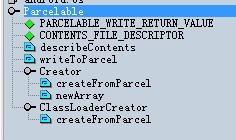Android Parcelable理解与使用(对象序列化)
http://my.oschina.net/zhoulc/blog/172163
parcel定义介绍:
android提供了一种新的类型:parcel(英文解释:包裹,小包),本类用来封装数据的容器,封装后的数据可以通过Intent或IPC传递,除了基本类型外,只有实现了Parcelable接口的类才能放入parcel中。
parcel一般都用在Binder通信,通过read和write方法进行客户端与服务端的数据传递(通信)。
比如:frameworks层服务端与hardware客户端的Binder通信
reply->writeInt32(getCardReaderSize());
int mid = data.readInt32();
用来存放parcel数据的是内存(RAM),而不是永远介质(Nand等)。
parcelable定义了把数据写入parcel和从parcel读出数据的接口,一个类的实例,如果需要封装到消息中去,就必须实现这一接口,如果实现了这个接口,该类的实例就是可以“被打包”。
Parcelable的定义:
下面我们看下parcelable的源码:

内容描述接口,没什么作用
public int describeContents();
写入接口函数,用来打包
public void writeToParcel(Parcel dest, int flags);
读取接口,目的是从parcel中构造一个实现了parcelable的类的实例对象,因为实现类这里是不可知的,所以需要用到模板的方法,继承类通过模板参数传入。
为了能够实现模板参数的传入,定义了creator嵌入接口,内涵两个接入函数分别是单个和多个继承类实例。
public interface Creator<T> {
public T createFromParcel(Parcel source);
public T[] newArray(int size);
}
还有一个子接口继承Creator,子接口只提供了一个函数,返回单个继承类实例
public interface ClassLoaderCreator<T> extends Creator<T>
Parcelable的实现使用:
Parcelabel 的实现,需要在类中添加一个静态成员变量 CREATOR,这个变量需要继承 Parcelable.Creator 接口。
|
1
2
3
4
5
6
7
8
9
10
11
12
13
14
15
16
17
18
19
20
21
22
23
24
25
26
27
28
29
30
31
32
33
34
35
36
37
38
39
40
41
42
43
44
45
46
47
48
49
50
51
|
package com.zlc.provider;import android.os.Parcel;import android.os.Parcelable;public class Students implements Parcelable{ private int stu_id; private String stu_name; public Students(Parcel source){ stu_id = source.readInt(); stu_name = source.readString(); } public int getStu_id() { return stu_id; } public void setStu_id(int stu_id) { this.stu_id = stu_id; } public String getStu_name() { return stu_name; } public void setStu_name(String stu_name) { this.stu_name = stu_name; } @Override public int describeContents() { // TODO Auto-generated method stub return 0; } @Override public void writeToParcel(Parcel dest, int flags) { // TODO Auto-generated method stub dest.writeInt(stu_id); dest.writeString(stu_name); } //Interface that must be implemented and provided as a public CREATOR field that generates instances of your Parcelable class from a Parcel. public final static Parcelable.Creator<Students> CREATOR = new Parcelable.Creator<Students>() { @Override public Students createFromParcel(Parcel source) { // TODO Auto-generated method stub return new Students(source); } @Override public Students[] newArray(int size) { // TODO Auto-generated method stub return new Students[size]; } };} |
Parcelable和Serializable的区别:
android自定义对象可序列化有两个选择一个是Serializable和Parcelable
一、对象为什么需要序列化
1.永久性保存对象,保存对象的字节序列到本地文件。
2.通过序列化对象在网络中传递对象。
3.通过序列化对象在进程间传递对象。
二、当对象需要被序列化时如何选择所使用的接口
1.在使用内存的时候Parcelable比Serializable的性能高。
2.Serializable在序列化的时候会产生大量的临时变量,从而引起频繁的GC(内存回收)。
3.Parcelable不能使用在将对象存储在磁盘上这种情况,因为在外界的变化下Parcelable不能很好的保证数据的持续性。


